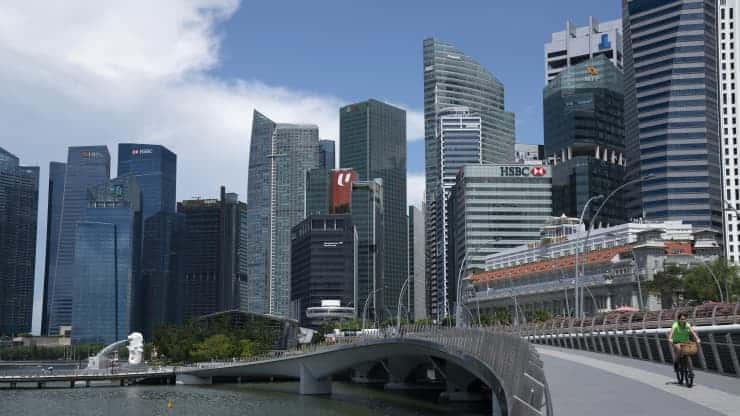Singapore’s central bank tightened monetary policy in a surprise move on Thursday as the economy grew 6.5% in the third quarter compared with a year ago.
The Monetary Authority of Singapore — the country’s central bank — said it raised the slope of its currency band “slightly” from the previous 0% rate of appreciation per annum.
That means the Singapore dollar is allowed to appreciate against a basket of currencies within an undisclosed band. The width of the band and the level at which it is centered are unchanged, the central bank said in its twice-yearly monetary policy statement.
The Singapore dollar rose around 0.2% to a three-week high of 1.349 per U.S. dollar following the central bank’s move.
The currency band is referred to as the Singapore dollar nominal effective exchange rate. The MAS manages monetary policy through setting the exchange rate, rather than interest rates. It adjusts the band through three levers: the slope, the mid-point and the width.
Eleven out of 13 economists polled by Reuters had expected the Singapore central bank to keep its policy unchanged.
MAS said adjustment to the currency band “will ensure price stability over the medium term while recognising the risks to the economic recovery.”
It expects core inflation — which strips out accommodation and private transport — to rise between 1% and 2% next year in the medium term. Core inflation is MAS’ preferred price gauge.
“Growth in the Singapore economy is likely to remain above trend in the quarters ahead. Barring a resurgence of the virus globally or a setback in the pace of economic reopening, output should return to around its potential in 2022,” said the central bank.
“At the same time, external and domestic cost pressures are accumulating, reflecting both normalising demand as well as tight supply conditions,” it added.
Song Seng Wun, economist at CIMB Private Banking said the move showed that MAS is confident about economic growth prospects and expects inflation to rise further. He explained that Singapore is “very exposed” to rising costs of energy and other goods internationally.
“So it’s really a case of to what extent they can contain imported inflation so perhaps this adjustment in the slope is recognizing that the [Singapore] dollar needs to be a bit more on the firm side to contain imported inflation,” Song told CNBC’s “Squawk Box Asia.”
Growth slightly missing estimates
Singapore’s economy grew 6.5% in the third quarter of 2021 compared to a year ago, official advance estimates showed on Thursday.
Analysts polled by Reuters had expected the Singapore economy to grow 6.6% year-on-year in the third quarter.
On a quarter-on-quarter seasonally adjusted basis, the economy expanded by 0.8%, Singapore’s Ministry for Trade and Industry said in a statement.
Here’s how the different sectors performed in the July-to-September quarter:
- Output in the construction sector jumped 57.9% from the same period a year ago.
- Manufacturing rose 7.5% compared to a year ago.
- Services-producing industries were up 5.5% year-on-year.
Singapore’s economy could pick up further in the coming quarters as the government eases Covid-19 restrictions and opens up for international travel, said Song.
Alex Holmes, Asia economist at Capital Economics, said he expects the Singapore central bank to leave monetary policy on hold in 2022.
Holmes said in a Thursday note that Covid-related economic weakness is still evident in Singapore. He noted that wholesale, retail and transport sector shrank 1.3% in the third quarter from the previous three months — the second straight quarterly contraction.
“The economic recovery still has some way to go,” he said.

